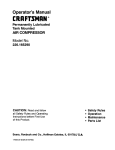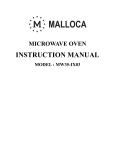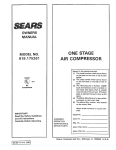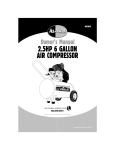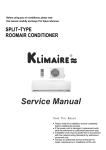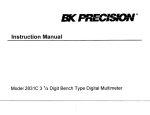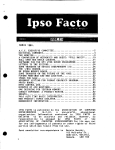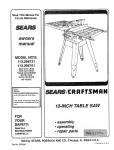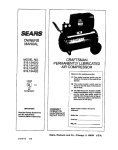Download Craftsman Air Compressor Specifications
Transcript
_ARS CRAFTSMAN GENERAL MANUAL FOR PERMANENTLY LUBRICATED TANK MOUNTED TWIN CYLINDER AIR COMPRESSOR NOTE: For identification of Re)air Parts, see separate Parts List Manual. Record in the spaces provided, (1) The mode_ number which can be found on the maintenance label on the top of the motor cover or on the tank, (2) The code number which can be found on the foil label on the rear of the air tank. (3) The Manufacturers Number is located on the metal data plate which is welded onto the backside of the air tank. (This data plate is painted the same color as the tank.) Retain these numbers for future reference. IMPORTANT: Read the Safety Guidelines and All Instructions Carefully SAFETY GUIDELINES ASSEMBLY OPERATION MAINTENANCE TROUBLESHOOTING REPAIR PARTS Model No. Code No. Mfg. No. Before Operating Sears, Roebuck I MG-PERMTWIN 6/18/93 I and Co., Chicago, IL 60684 U.S.A. TABLE OF CONTENTS Page WARRANTY ............................................................................................................................... SAFETY GUIDELINES WARNING ............................................................................................................... 2 3 CHART ..................................................................................................................... 3 ............................................................................................................................... 5 GLOSSARY ACCESSORIES FOR USE WITH SEARS AIR COMPRESSORS GENERAL INFORMATION DESCRIPTION ASSEMBLY ............................................... ........................................................................................................ OF OPERATION ............................................................................................... ................................................................................................................................ REMOVAL OF SHIPPING BOARDS AND INSTALLATION ........................................................ 5 5 6 7 7 INSTALLATION AND BREAK-IN PROCEDURES ...................................................................... Location of Air Compressor .................................................................................................. Lubrication and Oil ................................................................................................................ Extension Cords ................................................................................................................... Voltage and Circuit Protection .............................................................................................. Grounding Instructions ......................................................................................................... 7 7 7 8 8 8 OPERATING 9 PROCEDURES .................................................................................................... MAINTENANCE ....................................................................................................................... Air Filter- Inspection and Replacement .............................................................................. Check Valve -Replacement ................................................................................................ Safety Valve - Inspection .................................................................................................... Motor .................................................................................................................................. Storage .............................................................................................................................. 10 10 10 10 11 11 TROUBLESHOOTING 12 GUIDE ................................................................................................. HOW TO ORDER REPAIR PARTS ..................................................................... 16 FULL ONE YEAR WARRANTY ON AIR COMPRESSORS If this air compressor fails due to a defect in material orworkmanship within one year from the date of purchase, RETURN IT TO THE NEAREST SEARS SERVICE CENTER/DEPARTMENT THROUGHOUT THE UNITED STATES AND SEARS WILL REPAIR IT, FREE OF CHARGE, If this air compressoris used for commercial or rental purposes,the warrantywill apply for ninetydays from the date of purchase. This warrantygives you specificlegal rightsand you may have other rightswhich vary from state to state. Sears, Roebuck and Co., Sears Tower, Dept. 731CR-W, Chicago, IL 60684 SAFETY GUIDELINES This manual contains information that is important for you to know and understand. This information relates to protecting YOUR SAFETY and PREVENTING EQUIPMENT PROBLEMS. To help you recognize this information, we use the following symbols. Please read the manual and pay attention to these sections. URGENT SAFETY INFORMATION - A HAZARD THAT WILL CAUSE SERIOUS INJURY OR LOSS OF LIFE. IMPORTANT SAFETY INFORMATION A HAZARD THAT MIGHTCAUSE SERIOUS INJURY OR LOSS OF LIFE. NOTE Information equipment. for HAZARDS WHAT TO LOOK FOR Hot Parts preventing damage to information that you should pay special attention to. CAN OCCUR IF EQUIPMENT IS NOT USED PROPERLY. PLEASE READ THE FOLLOWING CHART. WHAT COULD HAPPEN HOW TO PREVENT IT The metal compressorcomponents,such as mani- Avoid contact with metal components of the compresfold, tubes, etc., become hotwhen the air compressor sor during or immediately after operation, Reaching is running. If you touch them, you may be seriously under or removing portions of the plastic enclosures such as the filter cover and console cover exposes hot burned. surfaces. Attowcompressor to cool prior to servicing. Flammable Vapors It is normal forthe motorandpressure switchto spark when compressorstartsor stops.A spark can ignite vapors from gasolineor solvents, causing a fire or explosion. If spraying a flammable material, provide ample ventilation. Never spray in a closed area. There must be a flow of fresh air at all times. Always operate the air compressor in well-ventilated areas, freeofgasolineorothersolventvapors. Do not operate the compressor near the spray area. Air Tank Modifications to air compressor components in an attempt to reach higher air pressure can cause the air tank to rupture or explode. Do not adjust, remove or tamper with the safety valve or pressure switch. If safety valve or pressure switch replacement is necessary, a part with the same ratings must be used. Incompatability between tank and compressor will cause the tank to rupture. Never replace the air tank with a different model or a larger tank. Return to Authorized Service Center if replacement is required. Modifications to the air tankwill cause ittc weaken. Never drill into weld or in any way modify the air tank. Thetankmay rupture or explode. Ifleaks deve op due to corrosion or tank is damaged, return to Authorized Service Center for replacement. 3 SAFETY WHAT TO LOOK FOR Compressed Air GUIDELINES WHAT COULD HAPPEN HOW TO PREVENT IT Compressed aircan propel dust, dirt or loose particles it comes in contact with. These propelled particles may cause serious injury or damage. Never point any nozzleor sprayertowarda personor any part of the body. Alwayswear safety gogglesor glasseswhenusingthe air compressor. Always turnthe air compressoroffb_ore attachingor removing accessories. Electricity Too much air pressure appliedto air toolsor accessories can cause damage or risk of bursting. Check the manufacturer's pressure rating for air tools and accessories. Regulator outl_ pressure must never exceed the maximum pressure rating. NOTE: IF A REGULATOR IS NOT SUPPLIED WITH YOUR COMPRESSOR, YOU MUST INSTALL ONE BEFORE USING AIR TOOLS AND ACCESSORIES WITH PRESSURE RATINGS LESS THAN 200 PSIG, Your air compressor is powered by electricity. Like any other electrically powered device, if it is not used properly it may cause electrical shock. Always unplug the air compressorprior to maintenance or repair. Never use the air compressor outdoors when it is raining. Always plug the cord into an electrical outlet with the specified voltage and adequate fuse protection. Toxic Vapors It is normal for compressed air to contain toxic or irritatingvapors. Suchvapors are harmful if inhaled. Never directlyinhalethe compressedair producedby this unit. Certain materials you are spraying (like paint, weed killer, sandor insecticide)can be harmfulif you inhale them. Read labels and safetydatafor all materialsyouspray. Followall safety precautions. Use a mask or respirator ifthera is a chance of inhaling toxic sprayed materials. Masks and respirators have limits and will only provide protection against some kinds and limited amounts of toxic material, Read mask and respirator instructions carefully. Consult with a safety expert or industrial hygienist if you are not sure about the use of a certain mask or respirator. Unsuitable Solvents 4 The solvents1,1,1 - Trichloroethaneand Methylene Ifthe material you intend to spray contains the solvents Chlodde canchemically reectwith aluminumused in listed at left (read the label or data sheet), do not use )aint spray guns, paint pumps, etc., and cause an accessories that contain aluminum or galvanized parts. explosion.These solventscan also react with galva- You must either change the material you intend to nizedcomponentsand cause corrosionand weaken- spray, or use only stainless steel spray equipment. ingof parts. This does not affectyourair compressor - but it may affect the equipmentbeing used. GLOSSARY CFM: Cubic feet per minute. SCFM: Standard cubicfeet per minute; a unit of measure of air delivery. PSIG: Pounds per square inch gauge; a unit of measure of pressure. ASME: American Society of Mechanical Engineers; made, tested, inspected and registered to meet the standards of the ASME. Cut-In Pressure: While the motor is off, air tank pressure drops as you continue to use your accessory. When the tank pressure drops to a certain low level the motor will restart automatically. The low pressure at which the motor automatically re-starts is called =cut-in pressure." Cut-Out Pressure: When you turn on your air compressor and it begins to run, air pressure in the airtank begins to build. It builds to a certain high pressure before the motor automatically shuts off - protecting your air tank from pressure higher than its capacity. The high pressure at which the motor shuts off is called =cut-out pressure." U.L. Listed: This product is Listed by UndenNriters Laboratories, Inc. (UL). Samples of this product have been evaluated by UL and meet the applicable UL Standards for Safety. ACCESSORIES FOR USE WITH SEARS AIR COMPRESSORS The following acoessodes are available through the current general sale catalog or at full-line Sears stores. .SPRAYGUNS .BLOWGUNS •AIR CAULKING GUNS .POWERWASHER .SANDBLASTERS *AIR BRUSHES •AIR LINE FILTERS •TIRE AIR CHUCKS •PAINT TANKS -AIRTANKS .INFLATORKITS •QUICK CONNECTOR SETS (various sizes) .VISCOSIMETER •AIR PRESSURE REGULATORS •OIL FOG LUBRICATORS -AIRTOOLS: Sanders DdUs Impact Wrenches Hammers •AIR HOSE: 114", 5/16" or 3t8" I.D. in vadous lengths GENERAL INFORMATION You have purchased an air compressor unit consisting of a 2 cylinder, single-stage air compressor pump and air tank. Included with portable compressors only are an air hose, tire air chuck, wheels, regulator, gauges, and handle. Stationary units are not supplied with regulators. This air compressor requires no oil. Now you can enjoy all the benefits of having an air compressor without ever having to purchase, add or change oil. Youraircompressor .NAILER/STAPLERS Decking Farming Roofing Siding Finishing Carpenting Upholstery Picture Framing •DRAIN CLEANER .DUSTERGUN guns, air tools, caulking sandblaster, or inflating weed killers, insecticides, required for most of the guns, grease guns, air brushes, tires and plastic toys, spraying etc. An air pressure regulatoris applications. An air filter which removes moisture and dirt from the compressed air should be used where applicable. These accessories can be purchased from most Sears stores. can be used foroperating paint spray 5 DESCRIPTION OF OPERATION Air Compressor Pump: To compress air, the pistons move up and down in the cylinders. On the downstroke, air is drawn in through the air intake valves. The exhaust valves remain dosed. On the upstroke of the piston, air iscompressed. The intake valves close and compressed air is forced out through the exhaust valves, through the outlet tubes, through the check valve and intothe air tank. Working air is not available until the compressor has raised the air tank pressure above that required at the air outlet. Check Valve: When the air compressor is operating, the check valve is =open", allowing compressed air to enter the air tank. When the air compressor reaches =cut-out" pressure, the check valve =closes", allowing air pressure to remain inside the air tank. Pressure Release Valve: The pressure release valve located on the side of the pressure switch, is designed to automatically release compressed air from the compressor head and the outlet tube when the air compressor reaches =cut-out" pressure or is shut off. If the air is not released, the motorwill not be able to start. The pressure release valve allowsthe motorto restart freely. When the motor stops running, air will be heard escaping from the valve for a few seconds. No air should be leaking when the motor is running. Pressure Switch: The pressure switch automatically starts the motor when the air tank pressure drops below the factory set =cut-in" pressure, It stopsthe motorwhen the air tank pressure reaches the factory set "cut-out" pressure, Globe Valve: Turn the knob counter-clockwise the valve and clockwise to close. Safety Valve: If the pressure switch does not shut off the air compressor at its cut-out pressure setting, the safety valve will protect the tank against high pressure by =popping out = at its factory set pressure (slightly higher than the pressure switch cut-out setting). Regulator:. The air pressure coming from the air tank is controlled by the regulator. Turn the regulator knob clockwise to increase pressure and counter-clockwise to decrease pressure. To avoid minor readjustment after making a change in pressure setting, always approach the desired pressure from a lower pressure. When reducing from a higher to a lower setting, first reduce to some pressure less than that desired, then bdng up to the desired pressure. Depending on the air requiroments of each particular accessory, the outlet regulated air pressure may have to be adjusted while operating the accessory. Outlet Pressure Gauge: The outlet pressure gauge indicates the air pressure available at the outlet side ofthe regulator. This pressure is controlled by the regulator and is always tess or equal to the tank pressure. See "Operating Procedures'. Tank Pressure Gauge: The tank pressure gauge indicates the reserve air pressure in the tank. Cooling System: This compressor contains an advanced design cooling system. At the heart of this cooling system is an engineered fan. It is perfectly normal for this fan to blow air through the vent holes in large amounts. You know that the cooling system is working when air is being expelled. to open Tools Needed for Assembly • a 9/16" socket or open end wrench for attaching the wheels or removing shipping beards • a 3/8" open end wrench or socket to tighten handle screws 6 ASSEMBLY Installing Wheels, Strip FOR PORTABLE COMPRESSORS Handles, Rubber Foot THE WI-IEELS AND HANDLE DO NOT PROVIDE ADEQUATE CLEARANCE, STABILITY OR SUPPORT FOR PULLING THE UNIT UP AND DOWN STAIRS OR STEPS. THE UNIT MUST BE LIFTED, OR PUSHED UP A RAMP. Attach the handle to the compressor saddle by inserting the handle inside the compressor saddle and lining up the two bolt holes on each side. Install the four screws, two on each side. Tighten securely. H may be necessary to brace or support one end of the outfit when attaching the wheels and the rubber foot strip because the air compressor will have a tendency to tip. Install one shoulder bolt and one nut for each wheel 2. using upper bolt hote for 30 and 33 gallon units. Tighten securely. The outfit will sit level if the wheels are propedy installed. 3. Clean and dry air tank leg opposite wheels. Remove the protective paper stdp from the adhesive backed rubber foot strip. Attach the rubber foot strip to the bottom of leg. Press firmly into place. REMOVAL OF SHIPPING BOARDS AND INSTALLATION FOR STATIONARY (PERMANENTLY MOUNTED) UNITS 2_ It may be necessary to brace or support one side of the outfit when removing the shipping boanJs because the air compressor will have a tendency to tip. , This compressor is designed to be bolted directly to a level floor. Prior to installing, place the newwashers which are supplied with the compressor, between the feet and floor such that the dng base at the bottom of the tank does not contact the floor. Tighten bolts 1520 tt. tbs. Remove all packaging such that only the compressor on the pallet remains. Remove and discard the (4) screws and washers that hold the compressor to the pallet. INSTALLATION AND BREAK-IN Location of the Air Compressor Locate the air compressor in a clean, dry and well ventilated area. The air filter must be kept clear of obstructions which could reduce air delivery of the air compressor, The air compressor should be located at least 12" away from the wall or other obstructions that will interfere with the flow of air. Theaircompressorheadand shroud are designed to allow for proper cooling. Lubrication and Oil This unit needs no lubrication or oiling. PROCEDURES Break-In Procedures The procedure is required only once, before the compressor is put into service. Operate the compressor with the regulator or shut-offvalve fully open for 15 minutes. Make sure that no pressure is building in the tank. After 15 mintues, close the regulator or shut-off valve and allow the tankto fill to cut-out pressure and then the motor will stop. Your compressor is now ready for use. Extension Cords Use extra air hose instead of an extension cord to avoid voltage drop and power loss to the motor, and to prevent overheating. If an extension cord must be used, be sure it is: a 3-wira extension cord that has a 3-blade grounding plug, and a 3-slot receptacle that will accept the plug on the product The portable air compressor is equipped with a cord having a grounding wire with an appropdate grounding plug. The plug must be used with an outlet that has been installed and grounded in accordance with all local codes and ordinances. The outlet must have the same configuration as the plug. See illustration. DO NOT USE AN ADAPTER. Inspect the plug and cord before each use. Do not use if there are signs of damage. in good condition no longer than 50 feet 12 gauge (AWG) or larger. (Wire size increases as gauge number decreases. 10 AWG and 8 AWG may also be used. DO NOT USE 14 OR 16 AWG.) Voltage and Circuit Protection Refer to your Parts List Manual for the voltage and circuit protction requirements of your compressor, Use only a fuse or circuit breakerthat isthe same rating as the branch circuit the air compressor is operated on. If the compressor is connected to a circuit protcted by fuses, use only dual element time delay fuses, as noted in that Service Bulletin. Refer to Parts List Manual for your compressor. Certain air compressor models can be operated on a 15 amp circuit if: 1. 2. 3. 4. Voltage supply to circuit is normal. Circuit is not used to supply any other electdcal needs (lights, appliances, etc.). Extension cords comply with specifications. Circuit is equipped with a 15 amp circuit breaker or 15 amp time delay fuse. Use a Fusetron Type T time delay fuse. If any of the above conditions cannot be met, or if operation of the compressor repeatedly causes interruption of the power, it may be necessary to operate it from a 20 am p circuit. It is not necessary to change the cord set. IMPROPER GROUNDING ELECTRICAL SHOCK. CAN RESULT IN Do not modify the plug that has been provided. If it does not fit the available outlet, the correct outlet should be installed by a qualified electrician. If repairing or replacing cord or plug, the grounding wire must be kept separate from the current-carrying wires. Never connect the grounding wire to a fiat blade plug terminal. The grounding wire has insulation with an outer surface that is green - with or without yellow stripes. If these grounding instructions are not completely understood, or if in doubt as to whether the compressor is propedy grounded, have the installation checked by a qualified electrician. 120Volt Model_ 24e Volt Medel= WhU= =ll AM_ P,,IKI 15 GROUNDOIG_ AMP PI.UG _ OLrTt'ET OUTUET Gt;IOU_ PIN Fm GROUNDING - Portable INSTRUCTION Compressors Wiring Instructions - Stationary (Permanently Mounted) Compressors RISK OF ELECTRICAL SHOCK. in the event of a shortcircuit,groundingreduces the risk of shock by providingan escape wire for the electriccurrent. This air compressor must be properly grounded. If your compressor is not equipped with a plug-in type power cord, perform electdcal wiring according to the following instructions: Refer to the Specification Chart in the Outfit Parts Bulletin for your compressor. RISKOF ELECTRICAL SHOCK. IMPROPER ELECTRICAL GROUNDING CAN RESULT IN ELECTRICAL SHOCK. WIRING FOR THE PRESSURE SWITCH SHOULD BE DONE BY A LICENSED ELECTRICIAN IN ACCORDANCE WITH NATIONAL AND LOCAL CODES AND ORDINANCES. 2. Install the compressor as close to the main power supply as possible. This practice will avoid using long lengths of electrical widng for the power supply which can cause power loss to the motor. When connecting wires, make sure that : Widng must be such that full motor nameplate voltage plus or minus 10% is available at the motor terminals during starting. Refer to local codes for recommended wire sizes for correct wire size and maximum wire run; undersize wire causes high amp draw and overheating to the motor. Electrical wiring must be located away from hot surfaces such as manifold assembly, compressor outlet tubes, beads, or cylinders. 1. The amperage rating of the electrical box is adequate. OPERATING 1. 2. PROCEDURES Before attaching air hose or acoessodes, make sure the OFF/AUTO lever is set to "OFF" and the air regulator or globe valve is closed. Attach hose and accessories. TOO MUCH AIR PRESSURE CREATES A HAZARDOUS RISK OF BURSTING. CAREFULLY FOU.OW STEPS 3 AND 5 EACH TIME THE COMPRESSOR IS USED. Compressed air from the outfit may contain water condensation. Do not spray untiltered air at an item that could be damaged. Some air operated tools or devices may require filtered air. Read the instructions for the air tool or device. 3. The supply line has the same electdcal characteristics (voltage, cycle, phase) as the motor. Check the manufacturer's maximum pressure rating for air tools and accossodes. The regulator outlet pressure must never exceed the maximum pressure rating. If your compressor is not supplied with a regulator with gauge, install one before using accessories. 4. Turn the OFF/AUTO leverto"AUTO" and allowtank pressure to build. Motor will stop when tank pressure reaches =cut-out" pressure. 5. Openthe regulatorbytuming it clockwise. Adjustthe regulator to the correct pressure setting. Your com- pressor is ready for use. 6. Always operate the air compressor in well-ventilated areas; free ofgasoline orothersolvent vapors. Do not operate the compressor near the spray area. When you are finished: 7, Setthe"OFFIAUTO"leverto=OFF ". 8. Turn the regulator counterclockwise and set the outlet pressure to zero. 9. Removethe airtool or accessory. 10. Open the regulator and allow the air to slowly bleed from the tank. Close the regulator when tank pressure is approximately 20 psi. 11. Drain waterfrem airtank. WATER WILL CONDENSE IN THE AIR TANK. IF NOT DRAINED, WATER WILL CORRODE AND WEAKEN THE AIR TANK CAUSING A RISK OF AIR TANK RUPTURE. With tank pressure at approximately 20 psi, open the drain cock or drain valve. NOTE: If drain cock valve is plugged, release all air pressure. The valve can then be removed, cleaned, then reinstalled. 12. After the water has been drained, close the drain cock or drain valve. The air compressor can nowbe stored. 9 MAINTENANCE iiiii UNIT CYCLES AUTOMATICALLY WHEN POWER IS ON. WHEN DOING MAINTENANCE, YOU MAY BE EXPOSED TO VOLTAGE SOURCES, COMPRESSED AIR OR MOVING PARTS. PERSONAL INJURIES CAN OCCUR. BEFORE PERFORMING ANY MAINTENANCE OR REPAIR, UNPLUG THE COMPRESSOR AND BLEED OFF ALL AIR PRESSURE. ALLMAINTENANCEAND REPAIROPERATIONSNOTLISTEDMUST BEDONEBY QUALIFIEDSERVICEPERSONNEL. Air Filter - Inspection and Replacement Check Valve Replacement - Portable Compressors Hot surfaces. Risk of burn. Compressor heads are exposed when filter cover is removed. Allow compressor to cool prior Risk of personal injury. Mainfold assembly contains compressed air which can be hxTardous. Manifold gets hot during operation. Before servicing: •Unplug or disconnect electdcel supply to compressor. -Bleed tank of pressure. •Allow compressor to cool. to servicing. _ Keep the air filter clean at all times. Do not operate the compressor with the air filter removed. A dirty air filter will not allowthe compressor to operate at full capacity. Before you use the compressor, check the air filter to be sure it is clean. t. 2. 3. 4. Check Valve - Replacement - Stationary (Permanently Mounted) Compressors 1. Release all air pressure frcm air tank and disconnect outfit from supply circuit. 2. Remove rear shroud. 3. Remove tubes and compression fittings at the tee and remove the tee from the check valve. 4. Remove the pressure release tube and fitting from the check valve. 5. Unscrew from the check valve (turn counterclockwise) using a socket wrench. 6. The check valve may be cleaned with a solvent, such as paint and varnish remover. 7. Apply sealant to the check valve threads. Reinstall the check valve (turn clockwise). DO NOT OVERTIGHTEN. 8. Replace the pressure release tube, fitting and tee. 9. Replace the outlet tubes and tighten fittings. 10, Replace the shroud. 11. Connect compressor to supply circuit, 10 Release all air pressure from air tank and unplug outfit. Remove console cover. Loosen lower ouUet tube nuts that secure outtet tubes to the upper manifold section. Remove the six screws secudng the upper manifold section to the lower section. 5. Lift upper manifold assembly and invert so that the flapper valve and o-dng are exposed. 6. Remove the two small screws secudng the flapper valve and restdctor. 7. Replace flapper valve and re-assemble restdctor and two screws. 8. Assemble upper manifold assembly to the lower section. Make sure the o-dng is retained in the upper section as it is inverted and the outlet tube slides into the upper section. Tighten six screws. 9. Tighten lower outfit tube nuts. 10. Replace console cover. Safety Valve - Inspection If the safety valve does not work properly, over-pressurization may occur, causing air tank rupture or an explosion. Before starting compressor, pull the ring on the safety valve to make sure that the safety valve operates fTeely. If the valve is stuck or does not operate smoothly, it must be replaced with the same type of valve. MAINTENANCE (cont'd) Storage The motor has an automatic msat thermal overload protector. If the motor overheats for any reason, the ovedoad protector will shut off the motor. The motor must be allowed to cool down before restarting. The compressor will automatically restart after the motor cools. Before you store the air compressor, the following: 1. make sure you do Review the =Maintenance" and "Operating Procedures" sections and perform maintenance as necessary. Be sure to drain water from the air tank. Protect the electrical cord and air hose from damage (such as being stepped on or run over). Wind them loosely around the compressor handle. If the ovedoed protector shuts the motor off frequently, check for a possible voltage problem. Lowvoltage can also be suspected when: 2. 1. 2. Store the air compressor in a clean and dry location. The motor does not get up to full power or speed. Fuses blow out when starting the motor; lights dim and remain dim when motor is started and is running. 11 Illllllll TROUBLESHOOTING GUIDE PERFORMING REPAIRS MAY EXPOSE VOLTAGE SOURCES, MOVING PARTS OR COMPRESSED AIR SOURCES. PERSONAL INJURY MAY OCCUR. PRIOR TO ATTEMPTING ANY REPAIRS, UNPLUG THE COMPRESSOR AND BLEED OFF TANK AIR PRESSURE. PROBLEM CAUSE CORRECTION Excessivetank pressure- safety valve pops off. Pressureswitchdoesnot shut offmctor when compressorreaches "cut-out" pressure. Movethe pressureswitchlevertothe'OFF =position. If the outt'rtdoesn'tshutoff, andtheelectricalcontacts are welded together, replacethe pressureswitch. Pressure switch'cut-out" too high. Return the outfit to Sears Service Center to check and adjust, or replace switch. Air leaks at fittings. Tube fittings are not tight enough. Tighten fittings where air can be heard escaping, Check t'rttings with soapy water solution, DO NOT OVER-TGHTEN. Airleaks atorinsidecheckvaive, Defective or dirty check valve. A defective check valve results in a constant air leak at the pressure release valve where there is pressure in thetank and the compressor is shut off. Remove and clean or replace check valve. Air leaks at pressure switch release valve. Defective pressure switch release Remove and replace the release valve. valve. If the contacts are good, checkto see if the pin in the bottom of the pressure release valve is stuck. If it does not move freely, replace the valve, Airleaks in airtank orat airtank welds. Defective check valve. A defective check valve results in a constant air leak at the pressure release valve when there is pressure in thetank and the compressor is shut off. Remove and clean or replace check valve. Defectiveair tank. Air tank must be replaced. Do not repair the leak. DO NOT DRILL INTO, WELD OR OTHERWISE MODIFY AIR TANK OR IT WILL WEAKEN, THE TANK CAN RUPTURE OR EXPLODE. Air leaks between head and valve plate, Pressure reading on the regulated pressure gauge drops when an accessory is used. Leaking seal. tt is normal for"some" pressure drop to occur. Torque head screws to 8 ft. Ibs. If this does not stop leak, replace seal. If there is an excessive amount of pressure drop when the accessory is used, adjust the regulator following the instructions on page 6. NOTE Adjust the regulated pressure under flow condilions (while accesory is being used). 12 TROUBLESHOOTING GUIDE (Continued) PROBLEM CAUSE CORRECTION Air leak from safety valve. Possible defect in safety valve. Operate safety valve manually by puning on ring. tf valve still leaks, it should be replaced. Knocking Noise Defective check valve. Remove and clean, or replace, Compressor is not supplying enough air to operate accessories. Prolonged excessive use of air. Decrease amount of air usage, Compressor is not large enough for air requirement. Check the accessory air requirement. If it is higher than the SCFM or pressure supplied by your air compressor, you need a larger compressor. Restricted air intake filter, Clean or replace air intake filter. Do not operate the air compressor in the paint spray area. Hole in hose, Check and replace if required. Check valve restricted. Remove and clean, or replace. Air leaks. Tighten f_ings. (See Air Leaks Section of Troubleshooting Guide,) Motor overload protection switch has tripped. Let motor cool off and overload switch will automati- Tank pressure exceeds pressure switch"cut-in" pressure. Motor will start automaticatly when tank pressure drops below "cut-in" pressure of pressure switch. Wrong gauge wire or length of extension cord. Check for proper gauge wire and cord length. Check valve stuck open. Remove and clean, or replace. Loose electrical connections. Check wiring connection inside pressure switch and terminal box area. Possible defective motor or capacitor. Return to Sears Service Center for inspection or replacement, if necessary. Motor will not run or restart. Paint spray on internal motor parts. Regulator knob continuous air leak, Regulator will not shut off at air outlet. cally reset. Have checked at Sears Service Center. Do not operatethe compressorin the paint spray area. See flammablevaporwarning, Fuse blown, circuit breaker tripped. 1_ Check fuse box for blown fuse and replace, if necessary. Reset circuitbreaker, Do not usea fuse orcircuitbreakerwithhigherratingthanthat specifiedfor your particularbranch circuit. 2. Check for properfuse; only "Fusetron"type T fuses are acceptable. 3. Check for low voltage conditionsand/or proper extensioncord, 4, Disconnectthe other electricalappliancesfrom circuit or operate the compressorin its own branchcircuit, Pressure release valve on pressure switch has not unloaded head pressure. Bleed the line by pushing the lever on the pressure switch tothe=ofr' position; ifthevalve does not open, replace it. Broken exhaust valve. Remove head and valve plate, inspect and replace if necessary, Dirty or damaged regulator internal )arts. Clean or replace regulator, or internal parts. 13 SERVICE NOTES 14 SERVICE NOTES m 15 _ VRS GENERAL MANUAL FOR CRAFTSMAN PERMANENTLY LUBRICATED TANK MOUNTED AIR COMPRESSOR SERVICE MODEL NO. HOW TO ORDER REPAIR PARTS Now that you have purchased your Sears Air Compressor, should a need ever exist for repair parts or service, simply contact any Sears Service Center and most Sears, Roebuck and Co. stores, Be sure to provide all pertinent facts when you call or visit. The model number of your Sears Air Compressor can be found on the label which is located on the top of the motor cover or on the tank. WHEN ORDERING REPAIR PARTS, ALWAYS LOWING INFORMATION: GIVE THE FOL- • PART NUMBER • PART DESCRIPTION • MODEL NUMBER • NAME OF ITEM All parts listed may be ordered from any Sears Service Center and most Sears stores. If the parts you need are not stocked locally, your order will be electronically transmitted to a Sears Repair Parts Distribution Center for handling. Sears, Roebuck and Co., Chicago, IL 60684 U.S.A.
















